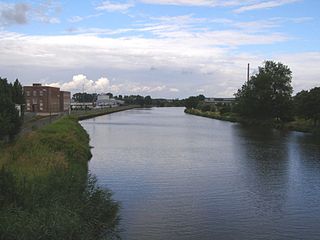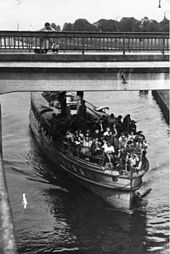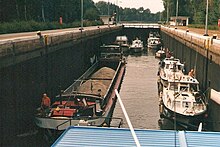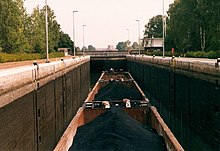Elbe-Havel Canal
| Elbe-Havel Canal | |
|---|---|
|
Course of the Elbe-Havel Canal and its side waterways |
|
| abbreviation | EHK |
| location | Germany: Saxony-Anhalt, Brandenburg |
| class | IV, on developed routes Vb |
| Beginning | Crossing from the Mittelland Canal near Hohenwarthe |
| The End | Confluence with the Untere Havel waterway |
| Descent structures | Zerbe , Wusterwitz |
| Historical precursors | Plauer Canal, Ihle Canal |
| Kilometrage | Ascending in the direction of the Havel (the Elbe-Havel Canal continues the kilometers of the Mittelland Canal to the Havel) |
| Ascent | Direction UHW |
| Competent authority | WSA Magdeburg to km 326.67, then WSA Brandenburg |
| Elbe-Havel Canal in Genthin to the east | |
The Elbe-Havel Canal (EHK) is a 55 kilometer long federal waterway in the federal states of Saxony-Anhalt and Brandenburg . It begins, passing over from the Mittelland Canal , at kilometer 325.70 ( 52 ° 14 ′ 40 ″ N, 11 ° 44 ′ 44 ″ E ) at the end of the lower outer lock port of the Hohenwarthe lock east of the Elbe near Magdeburg and then leads to the northeast east to Plauer See near Brandenburg an der Havel . There it ends at kilometer 380.90 on the Untere Havel waterway ( 52 ° 24 ′ 2 ″ N, 12 ° 25 ′ 10 ″ E ). Together with the Rhine-Herne Canal , the Wesel-Datteln Canal , the Dortmund-Ems Canal , the Mittelland Canal and the Havel and Spree and their canals, it creates a continuous waterway connection between the three classic first-order rivers Rhine , Elbe and Oder . The EHK is administered by the Magdeburg Waterways and Shipping Office up to km 326.67, and then by the Brandenburg Waterways and Shipping Office.
Legally, the federal waterways still belong to the EHK: Niegripper connecting canal , confluence of the Niegripper old canal (formerly Ihle Canal), Pareyer connecting canal (formerly Plauer Canal) with Baggerelbe , confluence of Bergzower Altkanal (formerly Ihle Canal), Altenplathower Altkanal (formerly Plauer Canal) , Roßdorfer Altkanal (formerly Plauer Canal), Woltersdorfer Altkanal (formerly Plauer Canal), waterway Kleiner Wendsee - Wusterwitzer See .
The name
The name Elbe-Havel Canal , which is now used to designate the waterway between the Elbe near Hohenwarthe and the Havel near Plaue , has become naturalized since construction work on the Mittelland Canal began in the early 1920s and was officially introduced by the Reich Ministry of Transport in 1938. The kilometering of the Mittelland Canal, which branches off in North Rhine-Westphalia with km 0.0 at km 108.35 of the Dortmund-Ems Canal near Bergeshövede , was continued with that of the Elbe-Havel Canal. If both sections (Mittelland Canal and Elbe-Havel Canal) also have different names, this uniform kilometering shows that they are part of a project, namely the connection between the Ruhr area and Berlin.
history
Today's Elbe-Havel Canal was created through the expansion and use of historical waterways between the Havel and the Elbe. The origins of the Plauer Canal and the Ihle Canal go back to the 18th century.
Plauer Canal
The Plauer Canal was built from 1743 to 1745 and initially connected the Havel near Plaue over a distance of 15 kilometers with the Stremme and Ihle rivers . Both rivers were also expanded for shipping. Another puncture over five kilometers then established a connection with an oxbow lake of the Elbe near Parey .
Ihle Canal
The Ihle Canal was built between 1865 and 1872 following an expansion of the Plauer Canal. This connected the Plauer Canal 1.5 kilometers north of Bergzow with the castle and a few kilometers north of Magdeburg flowed into the Elbe with a lock at Niegripp .
The time between the world wars
With the end of the First World War , the considerations for the expansion of the two canals to a more efficient waterway as a connection between the industrial areas on the Rhine and Ruhr with the industrial sites around Berlin were resumed. The first construction work began. The specifications for a connection between the major German rivers and rivers flowing from south to north had been concretised in the form of the continuous Mittelland Canal. These requirements were made law in December 1920. The first contracts for construction work were signed in 1926. At that time, it was assumed that five million tons of goods transported per year on this waterway could be expected. The canal was to be expanded for ships with maximum dimensions of 80.00 m × 9.00 m × 2.00 m or 80.00 m × 10.50 m × 1.60 m.
Construction work on the Plauer Canal and Ihle Canal dragged on, with temporary interruptions, until 1938. Construction began on the western end of the canal in 1936. Parts of the former Ihle Canal were deepened, widened and straightened. The aim was to achieve a water level of around 35 meters and a floor width of 25 meters. The water depth should not be less than 3.50 meters. This ensured that ships with a width of up to 10.50 m could meet across the entire canal without any problems. The line of the canal should not be less than a radius of curvature of 1000 m. Some punctures were made, which also shortened the route. The most important were the breakthrough at Parey with a length of 2.5 km, the one at Genthin with a length of 4.6 km and a section of the canal near Großwusterwitz with a length of 2.7 km.
Due to the new routing, the previous four canal stages with the Ihleburg lock and the Bergzow lock in the Ihle canal and the Kade lock and the Plaue lock in the Plau canal can be combined. The locks should have been enlarged in the course of the expansion anyway. With the reduction to the canal steps in Zorben and Großwusterwitz, construction, operating and maintenance costs could be saved. There were no waiting times for shipping at the locks. The old lock in Niegripp in the former Ihle Canal was closed and about 2.5 kilometers upstream a new breakthrough, the Niegripper connecting canal, was created with a lock to the Elbe. The New Niegripp Lock, as it was called at the time, was opened to traffic in 1938 after a two-year construction period.
Second World War and the GDR period
With the outbreak of the Second World War , the construction work to complete the Mittelland Canal and thus also the Elbe-Havel Canal was restricted or stopped. The canal section belonging to the Mittelland Canal in the immediate vicinity of the planned Hohenwarthe twin- aisle lift, as well as the lift itself and the canal bridge over the Elbe, were not completed either. In 1942 the construction work had to be finally stopped because of the war. Instead, the Rothensee descent canal to the Elbe and the Niegripp lock had to be used, which meant a detour of 12 km. ( See also: Magdeburg waterway intersection )
At the end of the Second World War, 13 of the 25 bridges that spanned the canal were destroyed. Most of the bridge debris was removed and since the locks in the canal all remained almost intact, shipping could be resumed as early as the summer of 1945. The maintenance of the canal that began during the GDR era was often able to guarantee the necessary diving depths and keep the fairway conditions at the minimum level. Due to the constant increase in shipping traffic and the enlargement of the ship's space and its drive power, there was damage in parts of the canal, with undermining of the bank reinforcements and downright embankments. The Elbe-Havel Canal developed into the most heavily traveled waterway in the GDR. This was also due to the fact that it was the most important connection on the waterway between the then Federal Republic of Germany and West Berlin , referred to as a transit route in the GDR .
Starting in 1973, work began on expanding and widening sections of the canal and removing bank breaks. It was dredged to ensure a nominal floor width and depth. In the period from 1979 to 1981, the Federal Republic of Germany made funds available for this construction work because, as it was said at the time, "... whose vehicles are significantly involved in causing the ... damage". A section of the canal between Seedorf and Genthin was modernized with a cross-sectional area of up to 170 m² and rock fillings up to the canal bottom.
After reunification
With the reunification of Germany, a project known as the German Unity Transport Project No. 17 to expand the waterway between Hanover via Magdeburg to Berlin was tackled in the early 1990s . This also implies an expansion of the Lower Havel waterway and the Mittelland Canal , including the Elbe-Havel Canal.
Locks
There are two canal levels in the Elbe-Havel Canal.
Zerbe lock (north chamber)
The Zerbe lock ( 52 ° 20 ′ 48 ″ N, 11 ° 57 ′ 51 ″ E ) was built between December 1934 and the end of 1938. A tow lock was built with a length of 225 meters and a width of 12 meters. The head and chamber walls of the lock are made of reinforced concrete. The sole is paved. The head of the lock is closed by a hinged gate , the lower head by a stem gate . There is a bridge over the lower head. There is a height-adjustable shock protection device under the bridge. The control building of the lock is also located at the lower head. The maximum drop height is 5.82 meters, the minimum 3.76 meters. The old lock is closed until further notice (as of June 2018).
Zerbe lock (south chamber)
To the south, directly next to the Zorben lock, the property was reserved for the construction of a second lock as early as the 1930s. The order for the southern lock in Zorien was placed in March 2013 by the Federal Ministry of Transport, Building and Urban Development . The cost of the project is around 14.2 million euros and is funded by 10 percent from the EU transport infrastructure budget ( TEN-T ).
The new lock chamber was opened to traffic on March 19, 2018. The marine call channel is VHF Channel 20.
Wusterwitz lock
The Wusterwitz lock, formerly also known as Großwusterwitz ( 52 ° 23 ′ 34 ″ N, 12 ° 21 ′ 40 ″ E ) , was built between 1927 and July 1930. A tow lock was built with a length of 225 meters and a width of 12 meters. Immediately next to the lock system, a piece of land was reserved for the construction of a second lock in the 1930s. This new lock is being built as part of transport project no. 17. Construction of the second lock at the Wusterwitz canal level began in 2009. The opening to traffic was planned for 2012. Due to delays in the construction work, commissioning is not expected until the end of 2013.
particularities
In addition to the two locks, when they were opened to traffic, an open space was built to drain excess water from the tributaries into the canal. Pump systems were built next to the locks to overcome water shortages in dry seasons. They should ensure that the upper reaches are filled with water from the lower reaches and from the Havel. At the end of 1938, the canal was completely navigable for 80-meter ships.
In the years 1956 to 1958, in addition to the constant preventive maintenance measures, extensive repair work was carried out on both locks for the first time. The rolling wedge gates were replaced by cylinder gates and the electrical systems were reconstructed.
bridges
Eighteen bridges cross the Elbe-Havel Canal, almost all of which were renewed after reunification.
Bike path
The Elbe-Havel-Radweg has been connecting Magdeburg with Berlin since 2017 and runs along the Elbe-Havel Canal.
See also
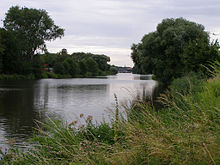
literature
- The province of Saxony in words and pictures . Volume I, Pestalozzi Association of the Province of Saxony. Published by Julius Klinkhardt, 1902, pp. 95 ff.
- Hans-J. Uhlemann: Berlin and the Märkische Wasserstraßen transpress Verlag, Berlin various years, ISBN 3-344-00115-9 .
- Herbert Sterz: Havel shipping under sail . Verlag MEDIA @ VICE, Pritzwalk 2005, ISBN 3-00-016065-5 .
- Writings of the Association for European Inland Shipping and Waterways eV various years. Western European shipping and port calendar inland shipping publishing house, Duisburg-Ruhrort
- Folke Stender (editor): Berlin & Märkische Waters (= sport shipping maps inland . Part 1). Nautical publication Verlagsges., Arnis 1993, ISBN 3-926376-10-4 .
Web links
Individual evidence
- ↑ a b Directory E, serial no. 10 der Chronik ( Memento of the original from July 22, 2016 in the Internet Archive ) Info: The archive link has been inserted automatically and has not yet been checked. Please check the original and archive link according to the instructions and then remove this notice. , Federal Waterways and Shipping Administration
- ↑ Lengths (in km) of the main shipping lanes (main routes and certain secondary routes) of the federal inland waterways ( Memento of the original from March 3, 2012 in the Internet Archive ) Info: The archive link was inserted automatically and has not yet been checked. Please check the original and archive link according to the instructions and then remove this notice. (PDF; 81 kB), Federal Waterways and Shipping Administration
- ↑ Lengths of the main shipping lanes of the federal inland waterways ( Memento of the original from January 21, 2016 in the Internet Archive ) Info: The archive link has been inserted automatically and has not yet been checked. Please check the original and archive link according to the instructions and then remove this notice. , Federal Waterways and Shipping Administration
- ↑ Directory F of the Chronicle ( Memento of the original from July 22, 2016 in the Internet Archive ) Info: The archive link was automatically inserted and not yet checked. Please check the original and archive link according to the instructions and then remove this notice. , Federal Waterways and Shipping Administration
- ^ Reichsverkehrsblatt A of December 23, 1938, p. 191.
- ↑ Waterways Construction Office
- ↑ locks
- ↑ Open to traffic for the southern chamber of the Zerben lock , accessed on March 20, 2018.
- ↑ Sluice Zorben
- ↑ Wusterwitz lock
- ↑ Publication of the Federal Waterways and Shipping Administration, as of July 2012.
- ↑ www.sachsen-anhalt-tourismus.de

